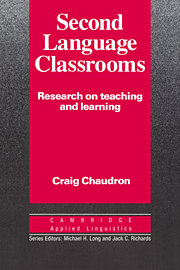Book contents
- Frontmatter
- Contents
- List of tables and figures
- Series editors' preface
- Preface
- 1 Major issues in second language classroom research
- 2 Classroom research methods
- 3 Teacher talk in second language classrooms
- 4 Learner behavior in second language classrooms
- 5 Teacher and student interaction in second language classrooms
- 6 Learning outcomes
- 7 Directions for research and teaching
- References
- Index
5 - Teacher and student interaction in second language classrooms
Published online by Cambridge University Press: 05 October 2012
- Frontmatter
- Contents
- List of tables and figures
- Series editors' preface
- Preface
- 1 Major issues in second language classroom research
- 2 Classroom research methods
- 3 Teacher talk in second language classrooms
- 4 Learner behavior in second language classrooms
- 5 Teacher and student interaction in second language classrooms
- 6 Learning outcomes
- 7 Directions for research and teaching
- References
- Index
Summary
In the previous two chapters ways in which teachers' and students' language use in classrooms might contribute to learning a second language have been described. In several places, especially in the sections on learners' interactive behaviors in Chapter 4, the importance of teacher-student interaction was proposed. In the view of many researchers and practitioners, conversation and instructional exchanges between teachers and students provide the best opportunities for the learners to exercise target language skills, to test out their hypotheses about the target language, and to get useful feedback. In this chapter, therefore, several of the factors that have been considered to influence the quality and quantity of teacher-student interaction are examined. The interaction which occurs as a result of these factors is described, and some of the likely consequences of the interaction for learners are suggested.
Four major areas are reviewed which exemplify the nature of interaction and its possible effects on TL learning: 1) selectivity of teachers' speech to L2 learners in mixed NS and NNS classes, 2) the variability in teachers' choice of language in addressing learners, 3) the pattern of questioning behavior, and 4) characteristics of feedback to learners following errors of L2 production or subject matter content. As was pointed out in Chapter 2, the particular perspective adopted by each researcher, whether from an ethnographic, discourse analytical, or interaction analytical position, results in different categories and units of analysis, making comparisons across studies difficult.
- Type
- Chapter
- Information
- Second Language ClassroomsResearch on Teaching and Learning, pp. 118 - 153Publisher: Cambridge University PressPrint publication year: 1988
- 1
- Cited by

